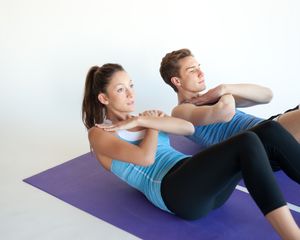Curl-ups
Original Editor - Lilian Ashraf
Top Contributors - Lucinda hampton, Sheik Abdul Khadir, Lilian Ashraf, Daan Vandebriel and Wanda van Niekerk
Introduction[edit | edit source]
The curl-up exercise is one of the most common exercises that target the abdominal muscles. The curl up exercise targets the abdominal muscles and works on the endurance of the abdominals and hip-flexors, important in back support and core stability.[1] Having abdominal muscles with high endurance helps prevent low-back pain.[2]
The curl-up requires use of the abdominal muscles to curl the upper body off the floor. It requires only a partial sit up and hence the hip flexors do not participate in the movement. Research has shown that in a full sit up the hip flexors do most of the work[2].
Curl-ups are performed in the crook-lying, supine position, by lifting the head, arms and upper trunk from the floor. Different curl-ups angles affect the abdominal muscles activity.[3]
Active Muscles and Risk factors[edit | edit source]
The curl-up involves flexion of the thoracic portion of the spine to lift the weight of the shoulders and head off the floor. This activity mainly activates the rectus abdominis, external oblique, internal oblique and transversus abdominis.[3]
The lumbar spine remains fixed during the movement. When the shoulders lift off the floor, the upper abdominals will contract harder to bring the torso forward for a more intense contraction. The hands are not placed behind the head as this encourages the subject to stress the neck and pull the head forward. [4]
Technique[edit | edit source]
The curl-up involves flexion of the thoracic portion of the spine to lift the weight of the shoulders and head off the floor, using the rectus abdominis assisted by the abdominal obliques. The lumbar spine remains fixed during the movement. When the shoulders lift off the floor, the upper abdominals will contract harder to bring the torso forward for a more intense contraction. The hands are not placed behind the head as this encourages the subject to stress the neck and pull the head forward. [4]
- Start in supine with with knees bent and feet comfortably flat on the floor;
- Adjust the pelvis so that the lumbar spine is in the neutral position.
- Curl up your head and bring your chin towards your chest, fixing your neck position as if you were holding an tennis ball between your chin and neck;
- Hands placed behind ears with elbows pointing out to the side.
- Focus on abdominals, curling upper back off the floor, not moving any other body part, keeping arms, shoulders, neck and legs relaxed as the abs pull you up. If the movement is performed correctly, the head and arms will curl up as one unit with your shoulders;
- Stop when the upper back is off the floor.
- Pause for one count at the top.
- Slowly lower the upper back down to the floor[4]
Clinical Application[edit | edit source]
To avoid over-stressing the spinal tissues it is recommended that the core strengthening routine does not exceed 60 repetitions of lumbar flexion cycles. For untrained individuals the training should start with a low volume 2 sets of 15 repetitions then progressively increase.
- A minimum of 48 hour to 72 hour rest should be allocated between dynamic spinal flexion exercise to allow the spinal tissue, muscles and intervertebral discs to remodel.
- Spinal flexion exercise shouldn’t be done until 1 hour of waking up, to decrease the risk of injury.[5]
The angle of the exercise is an important factor in the activity of the abdominal muscles.
- Maximum activity of the abdominal muscles was reported at 30 degrees eccentric curl-up angle, which is achieved by lifting only the shoulders from the floor.
- The activity of the abdominal muscles (rectus abdominis, external oblique and internal oblique) decrease as the curl-up angle increase (moving the body towards the vertical position) due to decrease in the body resistance torque.
- The transverses abdominis muscle acts as a corset contributing to the inter-segmental control of the lumbar spine, rather than contributing in trunk flexion.[3]
The speed of the exercise is also an important factor
- The faster the curl-up exercise is performed the higher the muscles' activation level but the lower the motor control level which could lead to increased risk of injury.
- Perform the exercise an optimal speed that allows both maximum activation of the abdominal muscles and adequate motor control. Barbado et al.(2015)[6] concluded that for active individuals the fastest cadence is 1 repetition/1 s that could be used, for other less active populations a slower curl-up speed is recommended to decrease the risk of injury and allow for motor control.[6]
References[edit | edit source]
- ↑ Top end sports Curl up Available: https://www.topendsports.com/testing/tests/abendur.htm(accessed 3.1.2022)
- ↑ 2.0 2.1 AZ central What Does the Curl Ups Test Measure?Available:https://healthyliving.azcentral.com/curl-ups-test-measure-10744.html (accessed 3.1.2022)
- ↑ 3.0 3.1 3.2 Ha SY, Shin DC. The effects of curl-up exercise in terms of posture and muscle contraction direction on muscle activity and thickness of trunk muscles. Journal of Back and Musculoskeletal Rehabilitation. 2020 Feb 28(Preprint):1-7.
- ↑ 4.0 4.1 4.2 Sports performance bulletin Abdominal strength training – the curl-up Available:https://www.sportsperformancebulletin.com/endurance-training/strength-conditioning-and-flexibility/abdominal-strength-training-curl/ (accessed 3.1.2022)
- ↑ Contreras B, Schoenfeld B. To crunch or not to crunch: An evidence-based examination of spinal flexion exercises, their potential risks, and their applicability to program design. Strength & Conditioning Journal. 2011 Aug 1;33(4):8-18.
- ↑ 6.0 6.1 Barbado D, Elvira JL, Moreno FJ, Vera-Garcia FJ. Effect of performance speed on trunk movement control during the curl-up exercise. Journal of human kinetics. 2015 Jun 1;46(1):29-37.







